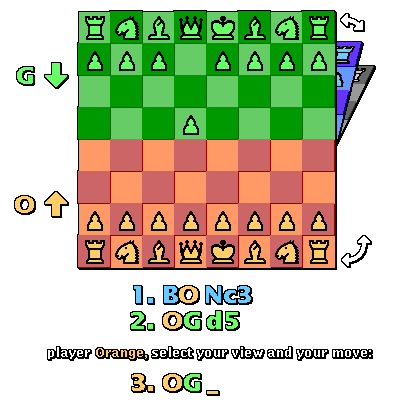Chess For Any Number of Players
by Ralph Betza ((email removed contact us for address) comm.com), invented roughly 1980, revised May 1995.

Introduction
This is a multi-player game of Chess in which any number of players may participate. This is (in my humble opinion) a fairly important Chess Variant invention, but it happened after I stopped writing my columns in NOST-alga, and it isn't suitable for postal play (which is where most of the organised CV action takes place), so it has been overlooked. To the best of my knowledge, only two games have ever actually been played, in the early 1980s; the players were, I think, Ralph Betza, Sid Sackson, Wayne Schmittberger, Phil Cohen, and Doug Grant.The idea is that each player gets a normal chess army plus half a chessboard, and moves are made by pushing any two half-boards together and then playing any legal move; armies get a movement bonus for having pieces on multiple boards, armies are captured by checkmate, and the last player alive wins.
The detailed rules which follow state the same idea in "official" terms. The clarifications sometimes explain why the rules are the way they are, and sometimes explain the finer points of the rules.
OFFICIAL RULES
Rule 1: The rules of FIDE chess apply, except as follows.Rule 2: Each player is provided with half a chessboard and a normal setup of pieces.
Clarifications: Of course, every player's pieces should be distinct from all the others'; I find that a dab of paint works wonders for this. For the half-boards, simply bisect some old cardboard boards.
Clarifications: According to Rule 7, players may come to be playing different armies than the ones they started with. It is important to remember that the batting order applies to the armies, not the players.
Rule 4: Whenever you move a piece, you push two half-boards together, and make any legal move.
Clarifications: You get to choose which half-boards you use for this, no restrictions at all, but even if your move takes place entirely on one half-board, you must still push two half-boards together.
Clarifications: The penalty for breaking this rule is that the other players may get angry at you! Play fair!
The alliances are "informal" because allied pieces can still give check to your King.
Clarifications: This rule means that you can't move the same piece twice in one turn, and you can't "bombard" one board by making captures into it from several other boards at once, and you can't move one piece onto a board and another piece off of the same board.
This rule also means that if you play Chess For Any Number of Players with only two players, the game is *EXACTLY* the same as FIDE chess!
Clarifications: This rule, and rule 7, are intended to prevent you from staying at home and waiting for the other players to weaken themselves by fighting.
Clarifications: It is possible to make a legal move and then discover that if two different boards are pushed together your King is in check! See Rule 8.
Clarifications: Armies controlled by the same player don't give check to each others' kings.
Clarifications: Allied pieces, controlled by other players, can still give check to your King, so they can be part of a mating net.
Clarifications: An army may change hands several times. You may gain some other army, lose your original army, and still be in the game.
If, when you push two boards together, your own King is in check, you must defend it: if you are checkmated, you lose! If the only two boards you can push together result in your being checkmated, you must do so anyway, and then cry.
Clarifications: In a friendly, social game, surely nobody will object if your allies recapture your army and let you play it, or let you play some other army, or let you take control while somebody goes out for a beer. In a cutthroat tournament game, things would be different. :-)
Rule 10: Enjoy the game, and if you prefer to substitute the rules for Xiang Qi, Avalanche Chess, Shogi, Stratego, or even checkers, feel free to do so!
Clarifications: This is really a general system for making a multi-player game out of any two-player game! It works well at game parties and chess clubs.
NOTES
The 1995 revision of the rules was written especially for Hans Bodlaender's _Chess Variants_ WWW home page. Rules 6 and 7 were tightened up and clarified, and rule 8 was added.If you try this game, please drop a line to me at (email removed contact us for address) comm.com.
Written by Ralph Betza (FM), (standard disclaimers apply) (email removed contact us for address) comm.com.
Multiboard graphic at top of page created by Claude Chaunier.
WWW page created: 1995. Last modified: April 8, 2000.
